IGT's ERP System: Implementation, Customization, and Change Management
VerifiedAdded on 2019/11/20
|8
|1504
|251
Report
AI Summary
This report examines the Enterprise Resource Planning (ERP) system implementation at IGT, an international game technology company. It outlines IGT's key goals for adopting an ERP system, including improving accounting, IT infrastructure, business process integration, customer service, operational efficiency, and revenue enhancement. The report analyzes the pros and cons of system customization, highlighting benefits like information management and quick customer support, while also addressing challenges such as high costs and implementation complexities. Furthermore, the report details IGT's approach to change management during ERP implementation, emphasizing strategies such as communicating benefits, providing training, setting expectations, fostering communication, and analyzing stakeholder involvement. The conclusion underscores the importance of ERP systems for achieving organizational objectives and suggests continuous improvement for maximizing future benefits.
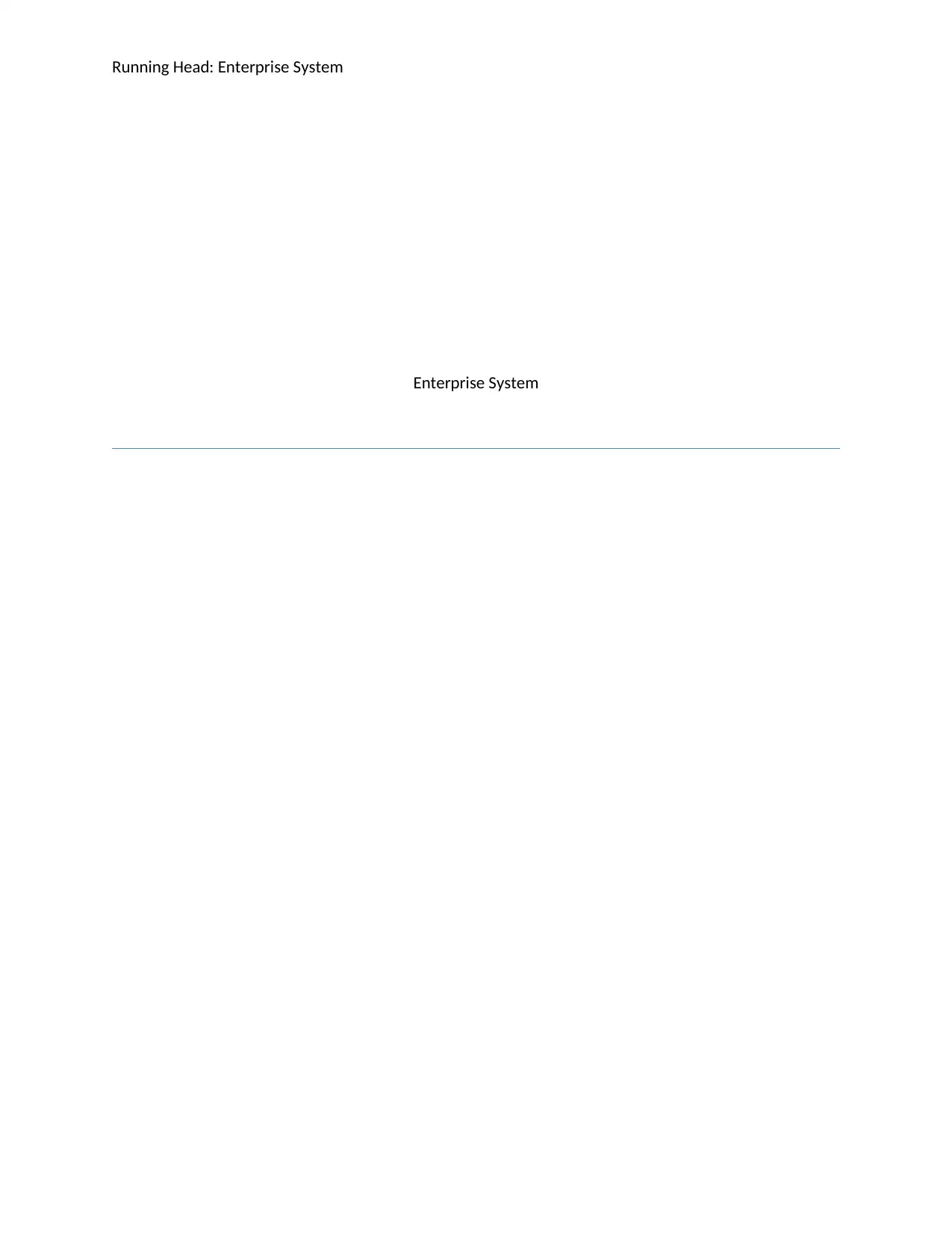
Running Head: Enterprise System
Enterprise System
Enterprise System
Paraphrase This Document
Need a fresh take? Get an instant paraphrase of this document with our AI Paraphraser
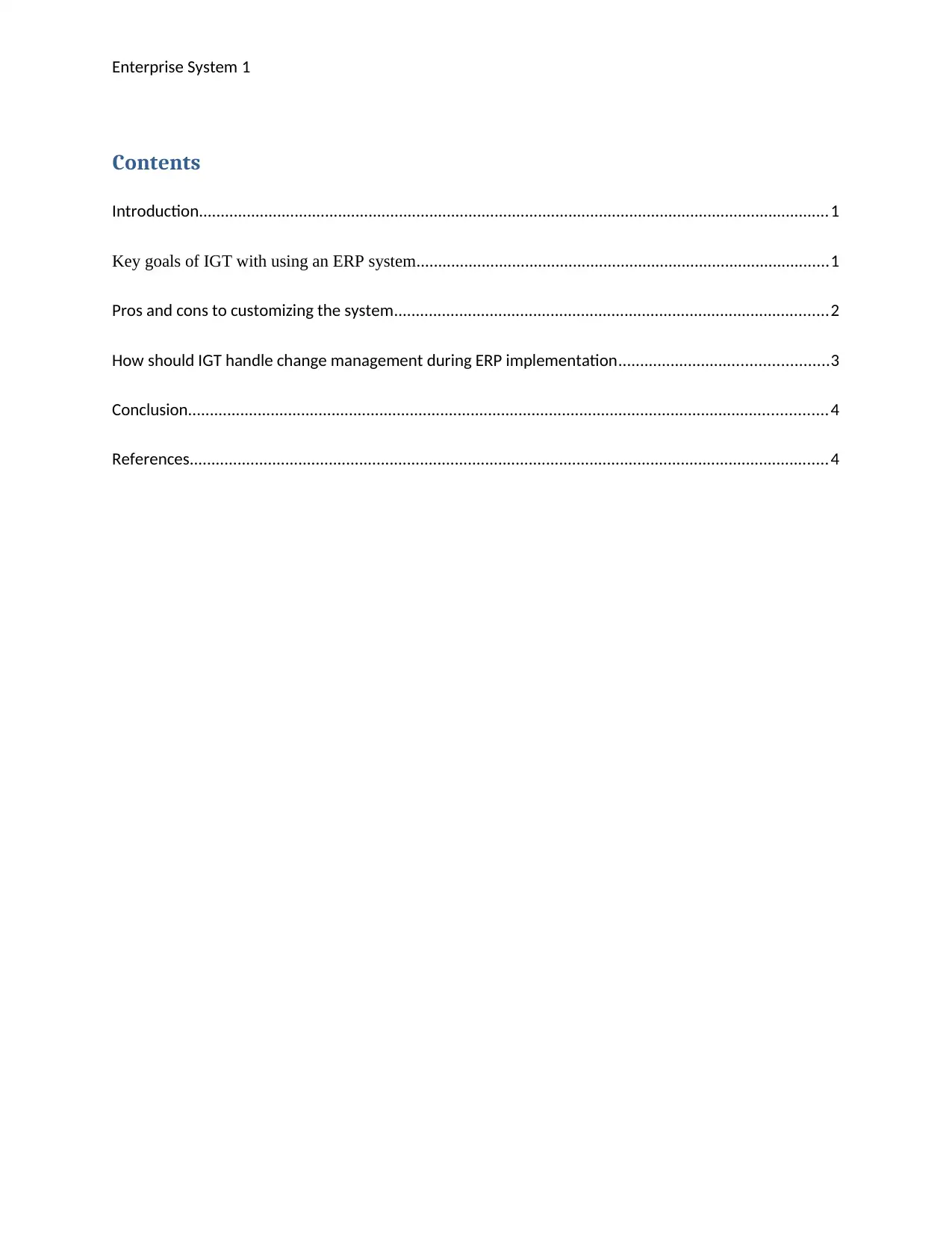
Enterprise System 1
Contents
Introduction.................................................................................................................................................1
Key goals of IGT with using an ERP system...............................................................................................1
Pros and cons to customizing the system....................................................................................................2
How should IGT handle change management during ERP implementation................................................3
Conclusion...................................................................................................................................................4
References...................................................................................................................................................4
Contents
Introduction.................................................................................................................................................1
Key goals of IGT with using an ERP system...............................................................................................1
Pros and cons to customizing the system....................................................................................................2
How should IGT handle change management during ERP implementation................................................3
Conclusion...................................................................................................................................................4
References...................................................................................................................................................4
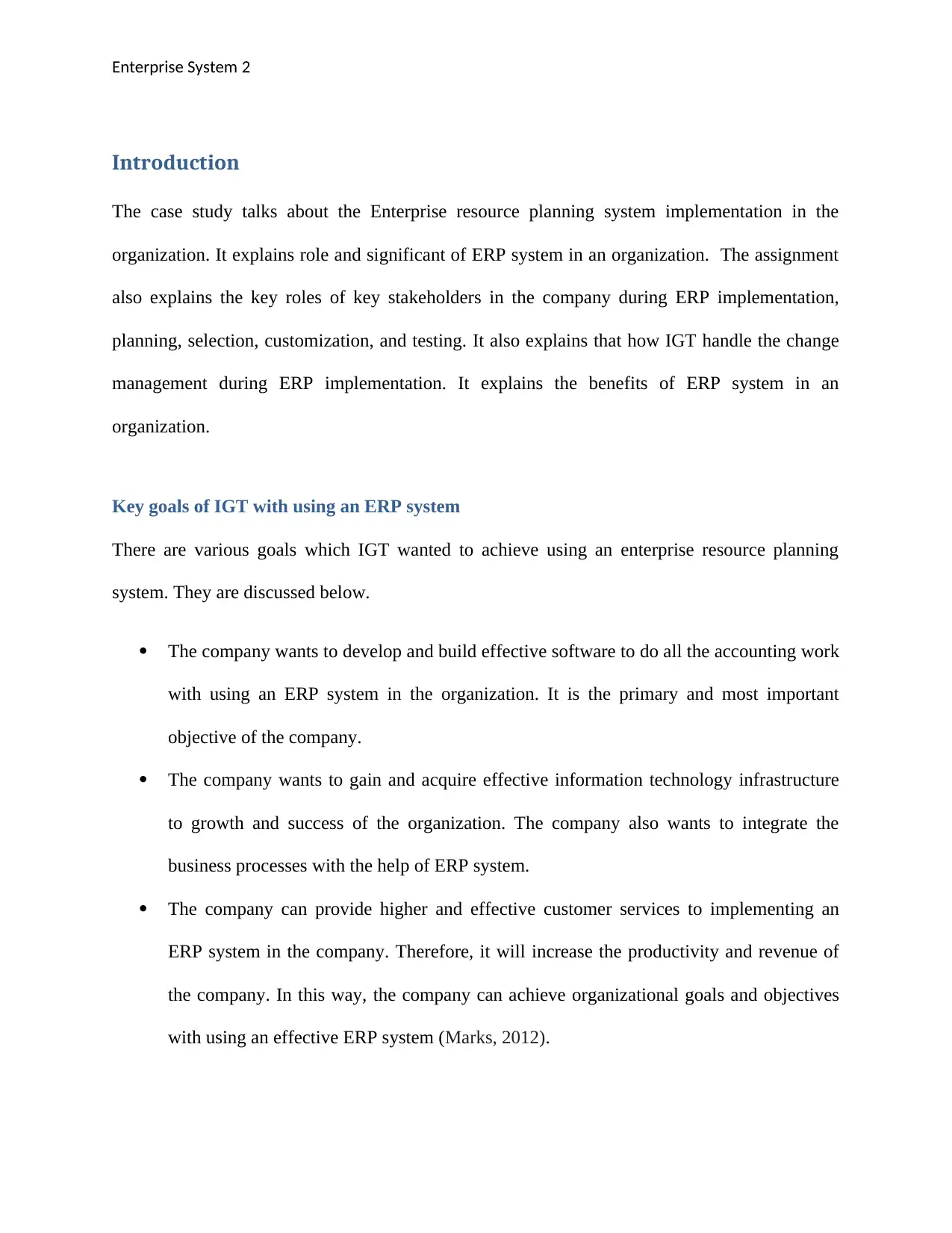
Enterprise System 2
Introduction
The case study talks about the Enterprise resource planning system implementation in the
organization. It explains role and significant of ERP system in an organization. The assignment
also explains the key roles of key stakeholders in the company during ERP implementation,
planning, selection, customization, and testing. It also explains that how IGT handle the change
management during ERP implementation. It explains the benefits of ERP system in an
organization.
Key goals of IGT with using an ERP system
There are various goals which IGT wanted to achieve using an enterprise resource planning
system. They are discussed below.
The company wants to develop and build effective software to do all the accounting work
with using an ERP system in the organization. It is the primary and most important
objective of the company.
The company wants to gain and acquire effective information technology infrastructure
to growth and success of the organization. The company also wants to integrate the
business processes with the help of ERP system.
The company can provide higher and effective customer services to implementing an
ERP system in the company. Therefore, it will increase the productivity and revenue of
the company. In this way, the company can achieve organizational goals and objectives
with using an effective ERP system (Marks, 2012).
Introduction
The case study talks about the Enterprise resource planning system implementation in the
organization. It explains role and significant of ERP system in an organization. The assignment
also explains the key roles of key stakeholders in the company during ERP implementation,
planning, selection, customization, and testing. It also explains that how IGT handle the change
management during ERP implementation. It explains the benefits of ERP system in an
organization.
Key goals of IGT with using an ERP system
There are various goals which IGT wanted to achieve using an enterprise resource planning
system. They are discussed below.
The company wants to develop and build effective software to do all the accounting work
with using an ERP system in the organization. It is the primary and most important
objective of the company.
The company wants to gain and acquire effective information technology infrastructure
to growth and success of the organization. The company also wants to integrate the
business processes with the help of ERP system.
The company can provide higher and effective customer services to implementing an
ERP system in the company. Therefore, it will increase the productivity and revenue of
the company. In this way, the company can achieve organizational goals and objectives
with using an effective ERP system (Marks, 2012).
⊘ This is a preview!⊘
Do you want full access?
Subscribe today to unlock all pages.

Trusted by 1+ million students worldwide
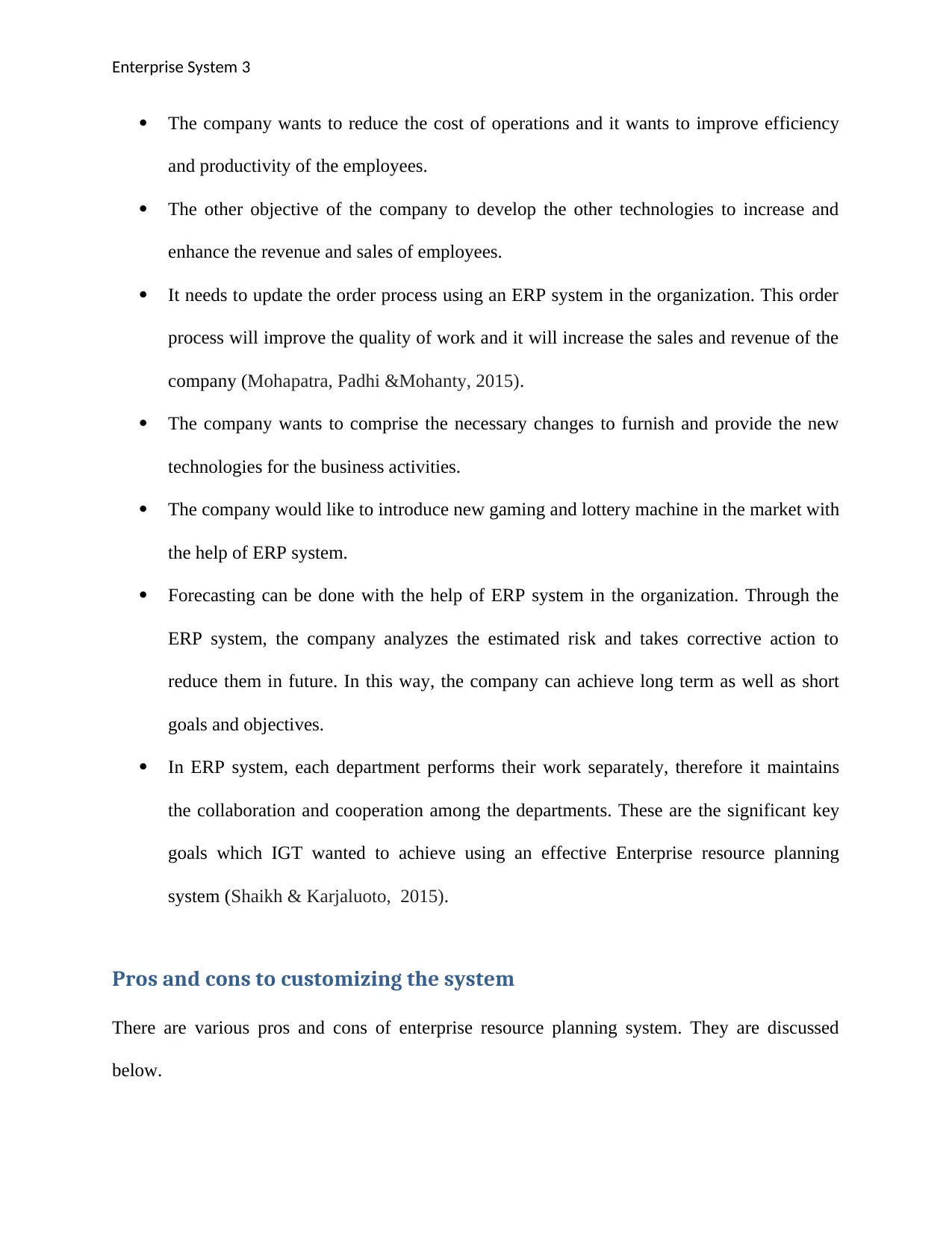
Enterprise System 3
The company wants to reduce the cost of operations and it wants to improve efficiency
and productivity of the employees.
The other objective of the company to develop the other technologies to increase and
enhance the revenue and sales of employees.
It needs to update the order process using an ERP system in the organization. This order
process will improve the quality of work and it will increase the sales and revenue of the
company (Mohapatra, Padhi &Mohanty, 2015).
The company wants to comprise the necessary changes to furnish and provide the new
technologies for the business activities.
The company would like to introduce new gaming and lottery machine in the market with
the help of ERP system.
Forecasting can be done with the help of ERP system in the organization. Through the
ERP system, the company analyzes the estimated risk and takes corrective action to
reduce them in future. In this way, the company can achieve long term as well as short
goals and objectives.
In ERP system, each department performs their work separately, therefore it maintains
the collaboration and cooperation among the departments. These are the significant key
goals which IGT wanted to achieve using an effective Enterprise resource planning
system (Shaikh & Karjaluoto, 2015).
Pros and cons to customizing the system
There are various pros and cons of enterprise resource planning system. They are discussed
below.
The company wants to reduce the cost of operations and it wants to improve efficiency
and productivity of the employees.
The other objective of the company to develop the other technologies to increase and
enhance the revenue and sales of employees.
It needs to update the order process using an ERP system in the organization. This order
process will improve the quality of work and it will increase the sales and revenue of the
company (Mohapatra, Padhi &Mohanty, 2015).
The company wants to comprise the necessary changes to furnish and provide the new
technologies for the business activities.
The company would like to introduce new gaming and lottery machine in the market with
the help of ERP system.
Forecasting can be done with the help of ERP system in the organization. Through the
ERP system, the company analyzes the estimated risk and takes corrective action to
reduce them in future. In this way, the company can achieve long term as well as short
goals and objectives.
In ERP system, each department performs their work separately, therefore it maintains
the collaboration and cooperation among the departments. These are the significant key
goals which IGT wanted to achieve using an effective Enterprise resource planning
system (Shaikh & Karjaluoto, 2015).
Pros and cons to customizing the system
There are various pros and cons of enterprise resource planning system. They are discussed
below.
Paraphrase This Document
Need a fresh take? Get an instant paraphrase of this document with our AI Paraphraser
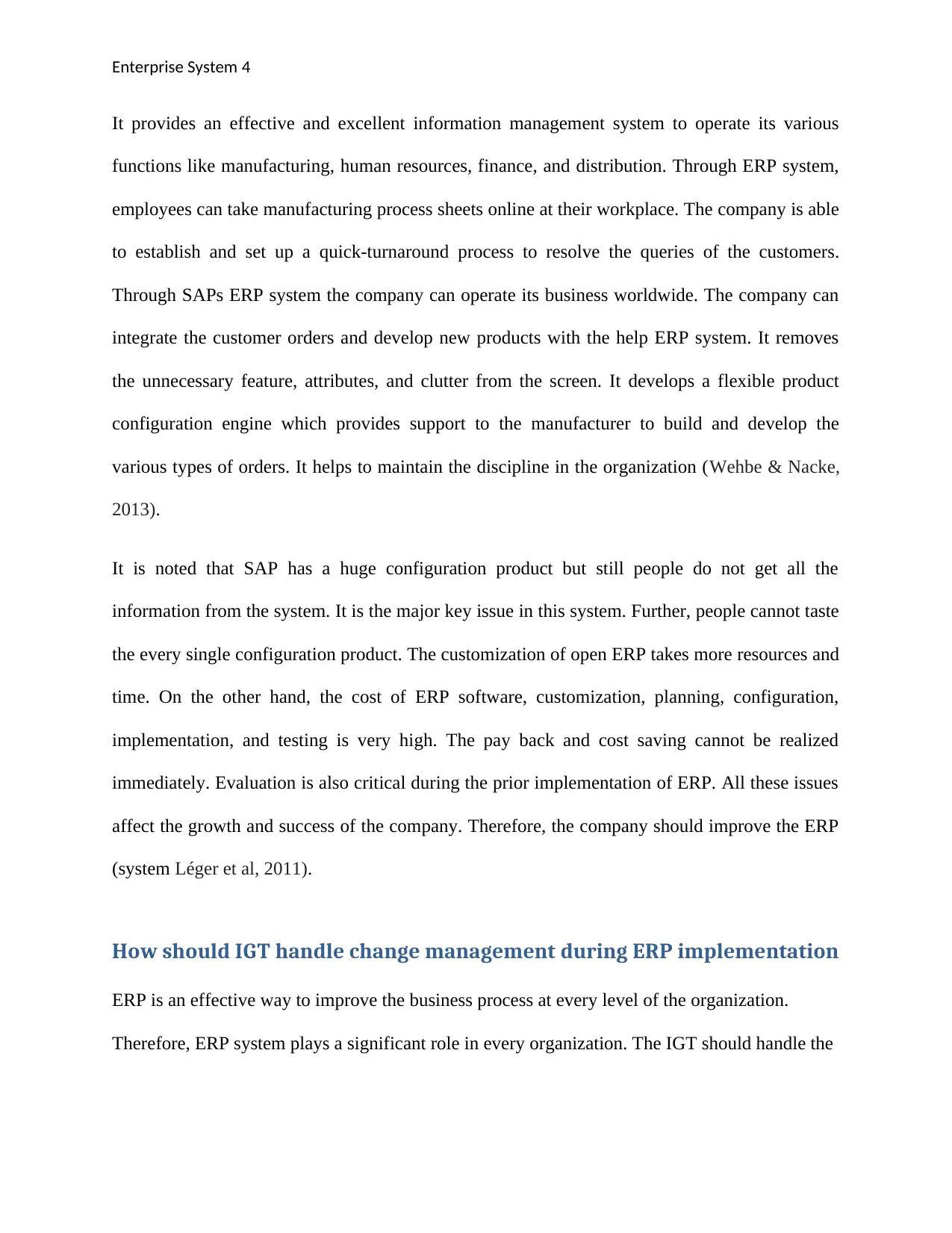
Enterprise System 4
It provides an effective and excellent information management system to operate its various
functions like manufacturing, human resources, finance, and distribution. Through ERP system,
employees can take manufacturing process sheets online at their workplace. The company is able
to establish and set up a quick-turnaround process to resolve the queries of the customers.
Through SAPs ERP system the company can operate its business worldwide. The company can
integrate the customer orders and develop new products with the help ERP system. It removes
the unnecessary feature, attributes, and clutter from the screen. It develops a flexible product
configuration engine which provides support to the manufacturer to build and develop the
various types of orders. It helps to maintain the discipline in the organization (Wehbe & Nacke,
2013).
It is noted that SAP has a huge configuration product but still people do not get all the
information from the system. It is the major key issue in this system. Further, people cannot taste
the every single configuration product. The customization of open ERP takes more resources and
time. On the other hand, the cost of ERP software, customization, planning, configuration,
implementation, and testing is very high. The pay back and cost saving cannot be realized
immediately. Evaluation is also critical during the prior implementation of ERP. All these issues
affect the growth and success of the company. Therefore, the company should improve the ERP
(system Léger et al, 2011).
How should IGT handle change management during ERP implementation
ERP is an effective way to improve the business process at every level of the organization.
Therefore, ERP system plays a significant role in every organization. The IGT should handle the
It provides an effective and excellent information management system to operate its various
functions like manufacturing, human resources, finance, and distribution. Through ERP system,
employees can take manufacturing process sheets online at their workplace. The company is able
to establish and set up a quick-turnaround process to resolve the queries of the customers.
Through SAPs ERP system the company can operate its business worldwide. The company can
integrate the customer orders and develop new products with the help ERP system. It removes
the unnecessary feature, attributes, and clutter from the screen. It develops a flexible product
configuration engine which provides support to the manufacturer to build and develop the
various types of orders. It helps to maintain the discipline in the organization (Wehbe & Nacke,
2013).
It is noted that SAP has a huge configuration product but still people do not get all the
information from the system. It is the major key issue in this system. Further, people cannot taste
the every single configuration product. The customization of open ERP takes more resources and
time. On the other hand, the cost of ERP software, customization, planning, configuration,
implementation, and testing is very high. The pay back and cost saving cannot be realized
immediately. Evaluation is also critical during the prior implementation of ERP. All these issues
affect the growth and success of the company. Therefore, the company should improve the ERP
(system Léger et al, 2011).
How should IGT handle change management during ERP implementation
ERP is an effective way to improve the business process at every level of the organization.
Therefore, ERP system plays a significant role in every organization. The IGT should handle the
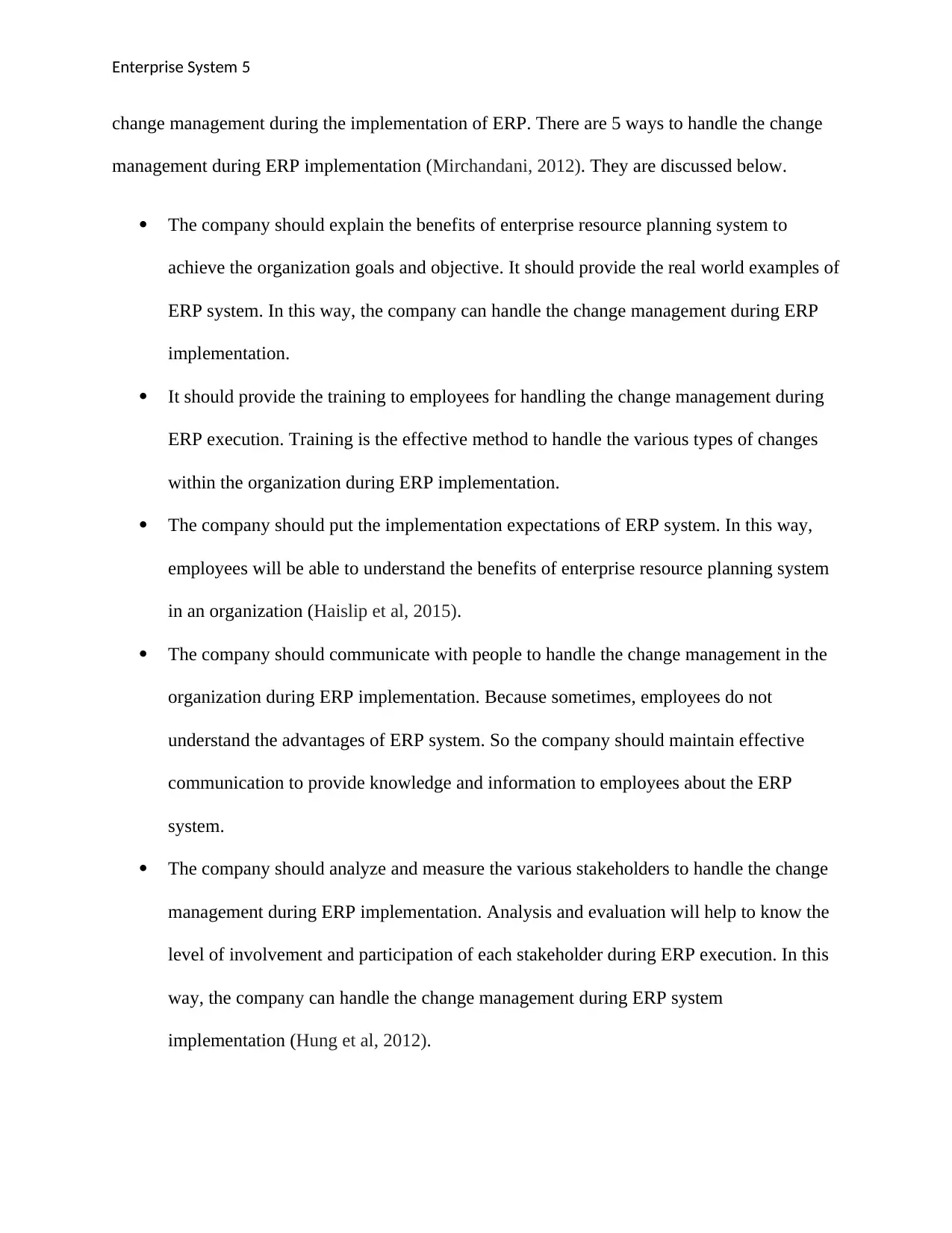
Enterprise System 5
change management during the implementation of ERP. There are 5 ways to handle the change
management during ERP implementation (Mirchandani, 2012). They are discussed below.
The company should explain the benefits of enterprise resource planning system to
achieve the organization goals and objective. It should provide the real world examples of
ERP system. In this way, the company can handle the change management during ERP
implementation.
It should provide the training to employees for handling the change management during
ERP execution. Training is the effective method to handle the various types of changes
within the organization during ERP implementation.
The company should put the implementation expectations of ERP system. In this way,
employees will be able to understand the benefits of enterprise resource planning system
in an organization (Haislip et al, 2015).
The company should communicate with people to handle the change management in the
organization during ERP implementation. Because sometimes, employees do not
understand the advantages of ERP system. So the company should maintain effective
communication to provide knowledge and information to employees about the ERP
system.
The company should analyze and measure the various stakeholders to handle the change
management during ERP implementation. Analysis and evaluation will help to know the
level of involvement and participation of each stakeholder during ERP execution. In this
way, the company can handle the change management during ERP system
implementation (Hung et al, 2012).
change management during the implementation of ERP. There are 5 ways to handle the change
management during ERP implementation (Mirchandani, 2012). They are discussed below.
The company should explain the benefits of enterprise resource planning system to
achieve the organization goals and objective. It should provide the real world examples of
ERP system. In this way, the company can handle the change management during ERP
implementation.
It should provide the training to employees for handling the change management during
ERP execution. Training is the effective method to handle the various types of changes
within the organization during ERP implementation.
The company should put the implementation expectations of ERP system. In this way,
employees will be able to understand the benefits of enterprise resource planning system
in an organization (Haislip et al, 2015).
The company should communicate with people to handle the change management in the
organization during ERP implementation. Because sometimes, employees do not
understand the advantages of ERP system. So the company should maintain effective
communication to provide knowledge and information to employees about the ERP
system.
The company should analyze and measure the various stakeholders to handle the change
management during ERP implementation. Analysis and evaluation will help to know the
level of involvement and participation of each stakeholder during ERP execution. In this
way, the company can handle the change management during ERP system
implementation (Hung et al, 2012).
⊘ This is a preview!⊘
Do you want full access?
Subscribe today to unlock all pages.

Trusted by 1+ million students worldwide
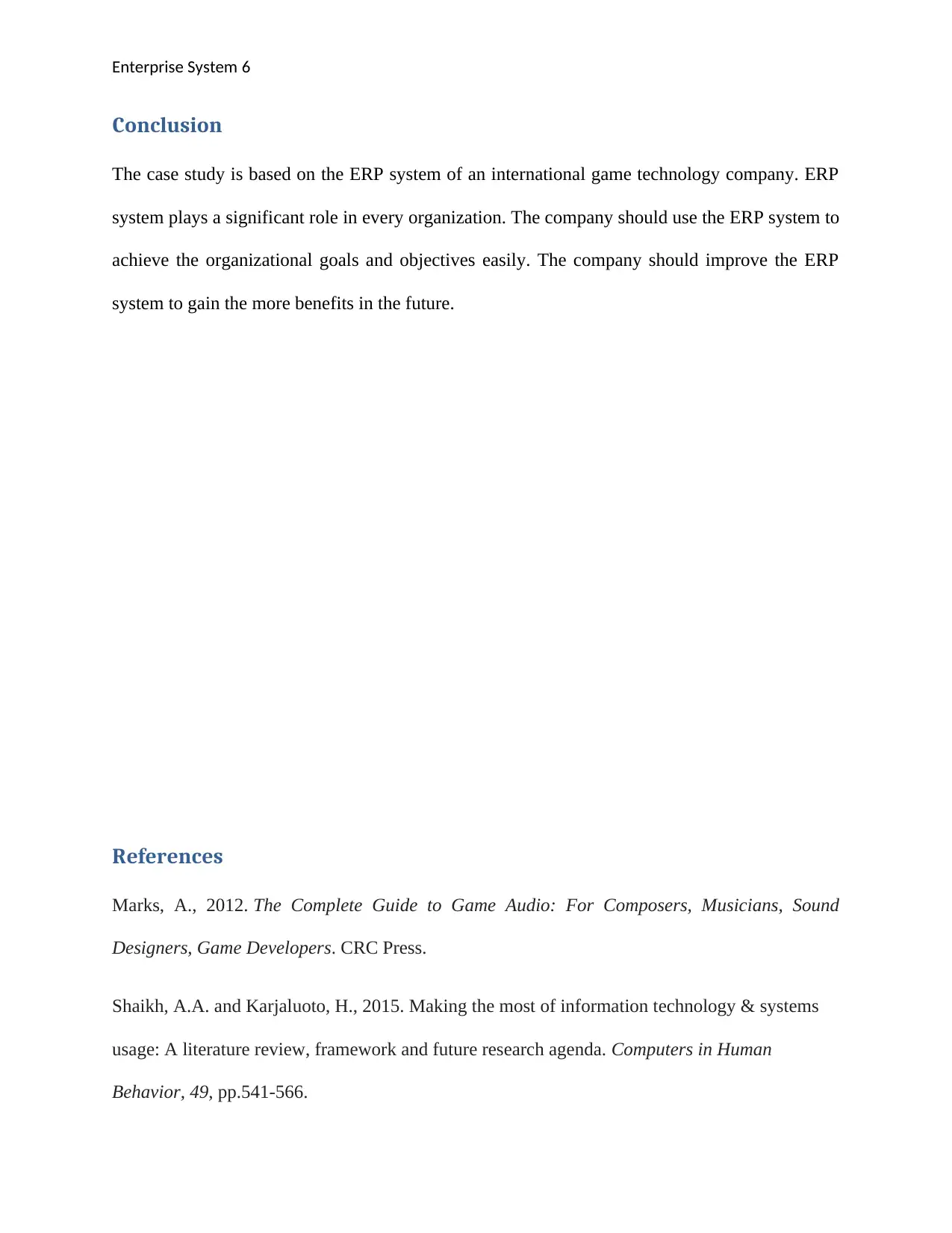
Enterprise System 6
Conclusion
The case study is based on the ERP system of an international game technology company. ERP
system plays a significant role in every organization. The company should use the ERP system to
achieve the organizational goals and objectives easily. The company should improve the ERP
system to gain the more benefits in the future.
References
Marks, A., 2012. The Complete Guide to Game Audio: For Composers, Musicians, Sound
Designers, Game Developers. CRC Press.
Shaikh, A.A. and Karjaluoto, H., 2015. Making the most of information technology & systems
usage: A literature review, framework and future research agenda. Computers in Human
Behavior, 49, pp.541-566.
Conclusion
The case study is based on the ERP system of an international game technology company. ERP
system plays a significant role in every organization. The company should use the ERP system to
achieve the organizational goals and objectives easily. The company should improve the ERP
system to gain the more benefits in the future.
References
Marks, A., 2012. The Complete Guide to Game Audio: For Composers, Musicians, Sound
Designers, Game Developers. CRC Press.
Shaikh, A.A. and Karjaluoto, H., 2015. Making the most of information technology & systems
usage: A literature review, framework and future research agenda. Computers in Human
Behavior, 49, pp.541-566.
Paraphrase This Document
Need a fresh take? Get an instant paraphrase of this document with our AI Paraphraser
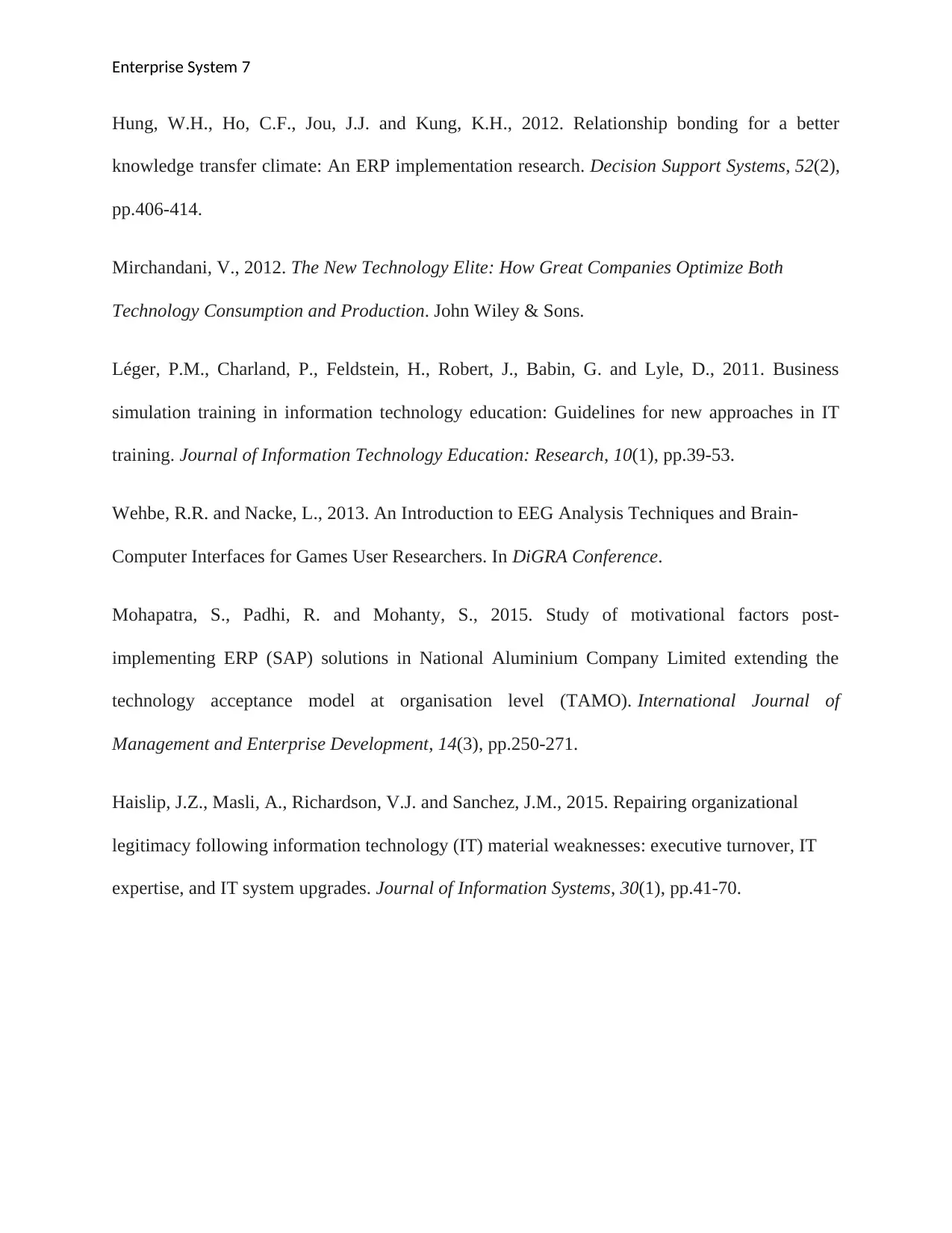
Enterprise System 7
Hung, W.H., Ho, C.F., Jou, J.J. and Kung, K.H., 2012. Relationship bonding for a better
knowledge transfer climate: An ERP implementation research. Decision Support Systems, 52(2),
pp.406-414.
Mirchandani, V., 2012. The New Technology Elite: How Great Companies Optimize Both
Technology Consumption and Production. John Wiley & Sons.
Léger, P.M., Charland, P., Feldstein, H., Robert, J., Babin, G. and Lyle, D., 2011. Business
simulation training in information technology education: Guidelines for new approaches in IT
training. Journal of Information Technology Education: Research, 10(1), pp.39-53.
Wehbe, R.R. and Nacke, L., 2013. An Introduction to EEG Analysis Techniques and Brain-
Computer Interfaces for Games User Researchers. In DiGRA Conference.
Mohapatra, S., Padhi, R. and Mohanty, S., 2015. Study of motivational factors post-
implementing ERP (SAP) solutions in National Aluminium Company Limited extending the
technology acceptance model at organisation level (TAMO). International Journal of
Management and Enterprise Development, 14(3), pp.250-271.
Haislip, J.Z., Masli, A., Richardson, V.J. and Sanchez, J.M., 2015. Repairing organizational
legitimacy following information technology (IT) material weaknesses: executive turnover, IT
expertise, and IT system upgrades. Journal of Information Systems, 30(1), pp.41-70.
Hung, W.H., Ho, C.F., Jou, J.J. and Kung, K.H., 2012. Relationship bonding for a better
knowledge transfer climate: An ERP implementation research. Decision Support Systems, 52(2),
pp.406-414.
Mirchandani, V., 2012. The New Technology Elite: How Great Companies Optimize Both
Technology Consumption and Production. John Wiley & Sons.
Léger, P.M., Charland, P., Feldstein, H., Robert, J., Babin, G. and Lyle, D., 2011. Business
simulation training in information technology education: Guidelines for new approaches in IT
training. Journal of Information Technology Education: Research, 10(1), pp.39-53.
Wehbe, R.R. and Nacke, L., 2013. An Introduction to EEG Analysis Techniques and Brain-
Computer Interfaces for Games User Researchers. In DiGRA Conference.
Mohapatra, S., Padhi, R. and Mohanty, S., 2015. Study of motivational factors post-
implementing ERP (SAP) solutions in National Aluminium Company Limited extending the
technology acceptance model at organisation level (TAMO). International Journal of
Management and Enterprise Development, 14(3), pp.250-271.
Haislip, J.Z., Masli, A., Richardson, V.J. and Sanchez, J.M., 2015. Repairing organizational
legitimacy following information technology (IT) material weaknesses: executive turnover, IT
expertise, and IT system upgrades. Journal of Information Systems, 30(1), pp.41-70.
1 out of 8
Related Documents
Your All-in-One AI-Powered Toolkit for Academic Success.
+13062052269
info@desklib.com
Available 24*7 on WhatsApp / Email
![[object Object]](/_next/static/media/star-bottom.7253800d.svg)
Unlock your academic potential
Copyright © 2020–2025 A2Z Services. All Rights Reserved. Developed and managed by ZUCOL.





